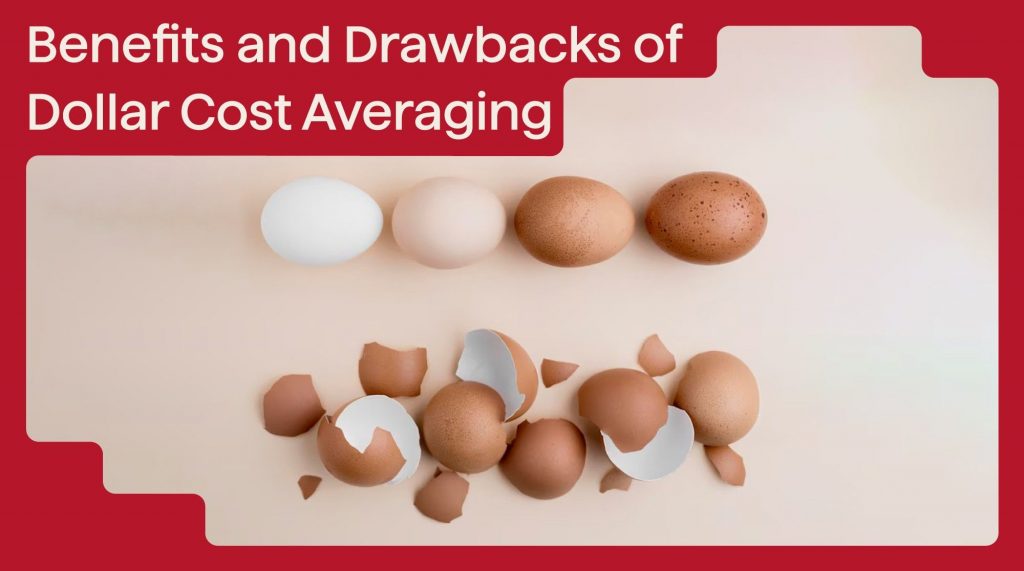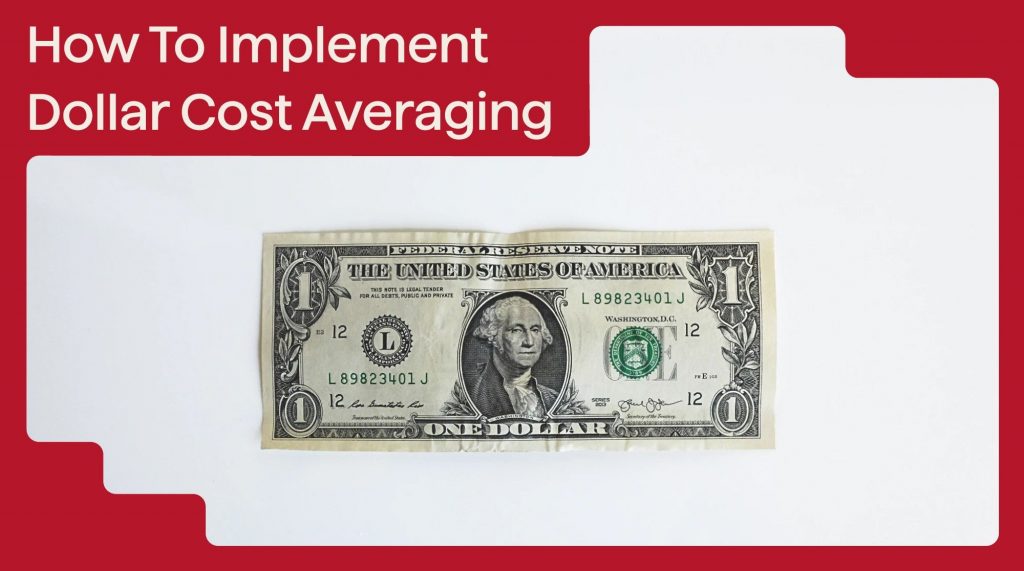When it comes to investing, there’s a strategy that has gained considerable attention for its ability to mitigate risk and provide a disciplined approach to growing your wealth: Dollar Cost Averaging (DCA).
In this article, we’ll delve into the concept of DCA, its mechanics, strategies, benefits, drawbacks, and everything you need to know to make informed investment decisions using dollar cost averaging for investing.
Unit cost averaging is another term for dollar cost averaging. While Pound cost averaging is a British term for dollar cost averaging.
Understanding Dollar Cost Averaging
Dollar Cost Averaging is a strategy where an investor allocates a fixed amount of money at regular intervals to purchase a specific investment, regardless of its price. This contrasts with the traditional lump sum investing, where a large amount is invested all at once. The beauty of DCA lies in its ability to remove the emotional burden of market timing and smooth out the impact of market volatility on your investments.
Dollar Cost Averaging (DCA) is a powerful investment strategy that offers a structured and disciplined approach to navigating the unpredictable world of financial markets. To fully grasp its potential, let’s delve deeper into the core concepts and mechanics that define DCA.
Explanation of Dollar Cost Averaging Concept
At its core, Dollar Cost Averaging is a form of systematic investing. DCA involves investing a fixed amount of money at regular intervals, regardless of market conditions. This contrasts with lump sum investing, where a large amount is invested all at once. The fundamental idea behind DCA is to remove the pressure of trying to time the market perfectly, a feat that even seasoned investors find challenging.
How DCA Works: Regular Investing


With DCA, you invest a predetermined amount of money on a consistent basis, such as weekly, monthly, or quarterly. Regardless of whether the market is experiencing highs or lows, you stick to your predetermined investment schedule. This approach allows you to buy more shares when prices are low and fewer shares when prices are high, effectively averaging out the cost of your investments over time.
Comparison with Lump Sum Investing
In contrast to DCA, lump sum investing involves putting a significant amount of money into the market all at once. While lump sum investing might seem appealing if the market is on an upswing, it carries the risk of unfortunate timing if markets take a downturn shortly after your investment. DCA, on the other hand, minimizes this risk by spreading out your investments over time.
Benefits of DCA: Risk Reduction and Emotional Discipline
One of the standout advantages of DCA is risk reduction. Since your investments are spread out over time, you’re less exposed to the full impact of sudden market declines. This can provide a sense of security, particularly during turbulent market periods.
Furthermore, DCA helps instill emotional discipline. The strategy encourages you to stay the course, regardless of short-term market fluctuations, effectively preventing you from making hasty decisions driven by fear or excitement.
Understanding the fundamental concepts of Dollar Cost Averaging is the first step in harnessing its potential for your investment journey. By consistently investing fixed amounts at regular intervals, regardless of market conditions, you benefit from reduced risk exposure and emotional discipline.
In the following sections, we’ll delve deeper into the mechanics, strategies, benefits, drawbacks, and expert insights related to DCA, equipping you with the knowledge to make well-informed investment decisions.
Dollar Cost Averaging: How It Works


To fully grasp the power of Dollar Cost Averaging (DCA), it’s essential to dive into the mechanics that underlie this investment strategy. From selecting the investment frequency to understanding its impact on your portfolio, this section explores the intricacies of how DCA works.
- Choosing Investment Frequency
The heart of DCA lies in its consistent investment frequency. You decide how often you want to invest, whether it’s weekly, bi-weekly, monthly, or any other interval that suits your financial situation. The key is to stick to your chosen frequency without being swayed by short-term market fluctuations. This regularity ensures that you benefit from the inherent averaging effect of DCA.
- Selecting the Investment Amount
Once you’ve determined your investment frequency, you need to decide on the fixed amount you’ll invest each time. This amount can vary based on your financial capabilities and objectives. It’s essential to strike a balance between an amount that’s meaningful for your financial goals and one that doesn’t strain your budget.
- Investment Mediums: Stocks, Mutual Funds, ETFs, Cryptocurrencies
DCA is a versatile strategy that can be applied to various investment vehicles. Whether you’re interested in stocks, mutual funds, exchange-traded funds (ETFs), or even cryptocurrencies, DCA can be adapted to suit your preferences. The underlying principle remains the same: investing fixed amounts at regular intervals to smooth out the impact of market volatility.
- Importance of Consistency in DCA
Consistency is the bedrock of DCA’s effectiveness. By adhering to your chosen investment frequency and fixed amount, you avoid the pitfalls of market timing. The goal is to remove the emotional burden of making investment decisions based on short-term market movements, thereby maintaining a disciplined approach to growing your investments over time.
Implementing DCA involves choosing the frequency at which you invest (e.g., weekly, monthly), determining the fixed investment amount, and consistently sticking to this schedule over time.
This approach allows you to buy more shares when prices are low and fewer shares when prices are high. By doing so, you avoid the pressure of trying to predict market movements and instead benefit from the concept of “buying the average.”
The mechanics of Dollar Cost Averaging revolve around consistency, discipline, and a long-term perspective. Choosing your investment frequency, deciding on the fixed amount, and understanding how DCA works across various investment mediums are critical steps.
By adhering to these principles, you harness the power of DCA to navigate the ebbs and flows of financial markets and work towards your investment objectives.
Dollar Cost Averaging Strategies


Implementing Dollar Cost Averaging (DCA) goes beyond simply investing a fixed amount regularly. Various strategies exist within the realm of DCA, each with its own nuances and considerations. In this section, we’ll explore different DCA strategies and the pros and cons of each.
- Fixed Amount Strategy
The fixed amount strategy involves investing the same dollar amount in your chosen investment at regular intervals, regardless of the current market price. This approach ensures consistency and simplifies the investment process. It’s suitable for investors seeking a straightforward method without the need for constant adjustments. However, during periods of high market volatility, your fixed investment might purchase fewer shares when prices are high and more shares when prices are low.
This strategy is one of the most common Dollar Cost Averaging strategies because it is the easiest to implement.
- Percentage of Income Strategy
This strategy involves allocating a certain percentage of your monthly income to your investments. As your income fluctuates, so does the investment amount. This method adjusts your investments based on your financial situation, which can be particularly helpful during times of income changes. However, this strategy might result in smaller investments during low-income months. This strategy is sometimes referred to as Incremental Averaging.
- Target Portfolio Allocation Strategy
With this strategy, you maintain a specific portfolio allocation by adjusting your investment amounts accordingly. If certain investments in your portfolio perform well and increase in value, you might redirect more funds into other investments to rebalance your portfolio. This approach ensures that your portfolio aligns with your risk tolerance and desired asset allocation. However, it requires ongoing monitoring and adjustments.
- Seasonal DCA Strategy
The seasonal DCA strategy involves adjusting your investment frequency based on market trends or specific times of the year. For example, you might increase your investments during traditionally strong market months and decrease them during historically weaker months.
While this approach aims to capitalize on market patterns, it requires accurate market timing, which can be challenging.
Benefits and Drawbacks of Dollar Cost Averaging


Dollar Cost Averaging (DCA) comes with its share of advantages and limitations. Understanding both sides of the coin is crucial for making informed decisions about whether DCA aligns with your investment goals and risk tolerance.
One of the major benefits of DCA is its ability to reduce the impact of market volatility. It’s particularly effective for risk-averse investors who want to minimize the potential negative outcomes of poor market timing. However, DCA may also result in missed opportunities if the market experiences prolonged upswings. Additionally, transaction fees associated with regular investments can eat into your returns.
Benefits of Dollar Cost Averaging:
- Mitigating Market Volatility:
DCA’s primary strength lies in its ability to reduce the impact of market volatility on your investments. By investing a fixed amount at regular intervals, you buy more shares when prices are low and fewer shares when prices are high. This averaging effect helps cushion your portfolio against extreme market fluctuations and help reduce your average purchase price. This phenomena is sometimes referred to as the Cost Averaging Effect.
- Disciplined Investing:
DCA encourages a disciplined approach to investing. Regardless of market sentiment or short-term trends, you consistently invest as planned. This helps prevent emotional decision-making driven by fear or greed, which can lead to suboptimal results in the long run.
- Reducing Timing Risk:
Trying to time the market perfectly is a challenging endeavor. DCA eliminates the need to predict market highs and lows, reducing the risks associated with mistimed investments. It allows you to avoid the pitfalls of making significant investments at unfavorable market conditions.
Drawbacks of Dollar Cost Averaging:
- Missed Opportunities:
While DCA’s gradual approach can shield you from market downturns, it might result in missed opportunities during extended bull markets. If the market experiences a sustained upward trajectory, your incremental investments might not fully capture the gains.
- Transaction Costs:
Implementing DCA often involves frequent transactions, which can lead to higher transaction costs. If your investment platform charges fees for each transaction, these costs can add up over time and potentially eat into your returns.
- Potential for Lower Returns:
In certain situations, lump sum investing might yield higher returns compared to DCA. If you have a substantial amount of capital available and the market is perceived to be undervalued, a lump sum approach could result in better outcomes. However, this approach carries higher risk due to its dependence on accurate market timing.
- Psychological Impact:
Dollar cost averaging helps mitigate emotional decision-making, but it can also create impatience during extended periods of stagnant or declining markets. Investors might become frustrated if they don’t see rapid growth in their portfolio, potentially leading to impulsive decisions.
- Lower Initial Exposure:
DCA’s gradual investment approach means that you have a lower initial exposure to potential gains. While this is intended to reduce risk, it also means that your initial investment might not benefit from immediate market upswings.
Dollar Cost Averaging offers a structured approach that can be particularly advantageous for risk-averse investors seeking a more controlled entry into the market. Its ability to manage market volatility, encourage disciplined investing, and reduce timing risk are substantial benefits. However, it’s important to consider the potential drawbacks, including missed opportunities and transaction costs. Ultimately, the suitability of DCA depends on your individual financial situation, investment goals, and risk tolerance.
Factors to Consider when Implementing DCA


Implementing Dollar Cost Averaging (DCA) involves more than just setting up a regular investment schedule. Several critical factors should guide your decision-making process to ensure that DCA aligns with your financial goals and circumstances.
- Investment Goals: Short-Term vs. Long-Term
Before adopting DCA, define your investment objectives. Are you aiming for short-term gains or planning for long-term wealth accumulation? DCA is particularly effective for long-term goals, as it smooths out market volatility and helps you avoid making impulsive decisions during market fluctuations. For short-term objectives, other strategies might be more suitable, given DCA’s focus on gradual growth.
- Risk Tolerance and Risk Capacity
Understanding your risk tolerance is crucial. DCA can help manage risk by spreading investments over time, but you should still be comfortable with the potential ups and downs of your chosen investment. Assess your risk capacity as well – the level of risk your financial situation can accommodate. DCA’s consistent approach can be reassuring during market downturns, but it’s essential to align with your risk profile.
- Market Trends and Economic Indicators
While DCA promotes a disciplined approach, staying informed about market trends and economic indicators can enhance your strategy. While you shouldn’t base your decisions solely on short-term trends, being aware of broader economic conditions can help you make informed adjustments to your investment plan.
- Flexibility of the Chosen Investment
Consider the investment you’re DCA-ing into. Certain investments are more amenable to DCA due to their lower volatility and long-term growth potential. Diversified assets like index funds or stable stocks might be more suitable for DCA, while highly speculative or volatile assets might require additional risk assessment.
- Tax Implications and Fees
DCA might have tax implications depending on your country’s tax laws. Be aware of how your investment gains or losses will be taxed over time. Additionally, consider transaction fees associated with each investment. Frequent buying can lead to higher fees, potentially affecting your overall returns. Analyze whether the benefits of DCA outweigh these costs.
- Reassessment and Adjustment
DCA is not a set-it-and-forget-it strategy. Regularly reassess your financial situation, goals, and the performance of your investments. Adjust your DCA plan if necessary. Life circumstances change, and your investment strategy should adapt accordingly.
Dollar Cost Averaging Myths and Facts


Addressing misconceptions about dollar cost averaging is crucial. While DCA doesn’t guarantee profits, it provides a disciplined and strategic approach to investing. Understanding the mathematical underpinnings of DCA returns and differentiating it from market timing can help clarify its effectiveness. Addressing these myths and providing factual insights is essential for understanding the true value of the DCA strategy. Below are general myths and facts about dollar cost averaging.
- Myth: Guaranteed Profits with Dollar Cost Averaging
Fact: While DCA is designed to mitigate the impact of market volatility, it’s not a guaranteed path to profits. DCA helps reduce the risk associated with poor market timing, but its effectiveness depends on market conditions. During prolonged bear markets, DCA can help minimize losses, but in bull markets, it might result in missed opportunities for significant gains.
- Myth: Timing the Market Doesn’t Matter with DCA
Fact: While DCA removes the need for precise market timing, it doesn’t mean that market conditions are irrelevant. Being aware of market trends and economic indicators can enhance your DCA strategy. DCA works best when combined with a basic understanding of broader market dynamics.
- Myth: DCA is Only for Small Investors
Fact: DCA is not limited to small investors. It’s a strategy that anyone can adopt, regardless of their investment size. Even individuals with substantial capital can benefit from DCA as a means to manage risk and avoid making lump sum investments during uncertain market conditions.
- Myth: DCA Guarantees Lower Risk
Fact: DCA can help manage risk, but it doesn’t eliminate it entirely. Investments are subject to market volatility, and while DCA spreads out the risk over time, there’s still the possibility of loss. Risk is inherent in any investment, and DCA doesn’t exempt you from market fluctuations.
- Myth: DCA is Always Inferior to Lump Sum Investing
Fact: Whether DCA is inferior to lump sum investing depends on various factors, including market conditions, risk tolerance, and investment goals. While DCA might result in lower returns during extended bull markets, it can prove to be a prudent strategy during uncertain or volatile times.
- Myth: DCA is Only Effective for Stocks
Fact: While DCA is often associated with stock investments, it can be applied to a wide range of assets, including mutual funds, exchange-traded funds (ETFs), bonds, and even cryptocurrencies. The key is to evaluate the asset’s volatility, growth potential, and your investment objectives.
- Myth: DCA is Set-and-Forget
Fact: While DCA offers a systematic approach, it’s not entirely set-and-forget. Regular assessment and adjustment of your investment plan are necessary. Life circumstances change, and your financial goals might evolve over time, requiring adjustments to your DCA strategy.
- Myth: DCA Eliminates All Emotion from Investing
Fact: While DCA reduces emotional decision-making, it doesn’t eliminate all emotional influence. Market downturns can still evoke feelings of unease, even when using the DCA strategy. However, DCA provides a structured framework that helps mitigate impulsive decisions.
- Myth: DCA is Always Better than Lump Sum Investing for Long-Term Growth
Fact: The effectiveness of DCA versus lump sum investing depends on various factors, including the specific investment, market conditions, and your risk tolerance. DCA is more about risk management and consistency than guaranteeing higher returns.
- Myth: DCA is a One-Size-Fits-All Strategy
Fact: DCA is a flexible strategy that can be adapted to individual preferences and circumstances. Different investors have varying risk tolerances, investment goals, and market outlooks. Tailoring your DCA approach to suit your unique situation is key to its success.
By dispelling these myths and highlighting the facts surrounding Dollar Cost Averaging, I hope you can make well-informed decisions about whether this strategy aligns with your investment objectives.
The benefits of dollar cost averaging (DCA)are real, but it’s important to understand its limitations and nuances to utilize it effectively in your investment journey.
How To Implement Dollar Cost Averaging: Step-by-Step Guide


Implementing Dollar Cost Averaging (DCA) requires thoughtful planning and execution. This step-by-step guide will walk you through the process of adopting DCA as an investment strategy, helping you navigate the intricacies and make informed decisions along the way.
- Assess Your Financial Goals and Risk Profile
Before embarking on any investment strategy, define your financial goals and risk tolerance. Are you investing for retirement, buying a home, or seeking short-term gains?
Understanding your goals helps tailor your DCA strategy to align with your aspirations. Additionally, assess your risk tolerance to ensure that DCA matches your comfort level with market fluctuations.
- Choose the Appropriate DCA Strategy
Consider the DCA strategy that suits your investment goals and financial situation. Whether it’s the fixed amount, percentage of income, target portfolio allocation, or seasonal DCA, each strategy has its merits. The choice depends on your level of involvement, risk tolerance, and desired outcomes.
Automation is a key aspect of successful DCA. Most investment platforms like Bamboo allow you to set up automatic transfers from your bank account to your chosen investments. This ensures that you stick to your predetermined investment schedule without the need for constant manual intervention.
- Monitor and Adjust DCA Over Time
While DCA is designed to be a consistent strategy, it’s essential to periodically review and adjust your approach. Regularly assess whether your chosen strategy aligns with your changing financial circumstances, goals, and market conditions. Be open to making adjustments as needed while staying true to your long-term investment objectives.
- Importance of Staying Informed
Even though DCA emphasizes consistency, staying informed about market trends and economic developments is crucial. While you’re not timing the market, having a general awareness can help you make informed decisions about your investment plan. Regularly read up on financial news and stay in touch with your investments’ performance.
Implementing Dollar Cost Averaging involves understanding your goals, selecting a suitable strategy, automating your investments, and regularly reviewing your plan. By following this step-by-step guide, you’ll be equipped to navigate the world of investments with a disciplined and consistent approach.
Remember, DCA is a long-term strategy, and success often comes from patiently adhering to your plan through various market conditions.
FAQs About Dollar Cost Averaging


Can I use Dollar Cost Averaging for retirement savings?
Yes, Dollar Cost Averaging can be a sensible strategy for retirement savings. By consistently investing over time, you’re contributing to your retirement fund in a disciplined manner. However, the effectiveness of DCA for retirement savings depends on your time horizon, risk tolerance, and the performance of your chosen investments.
Is Dollar Cost Averaging a guaranteed way to make profits?
While Dollar Cost Averaging (DCA) can help mitigate the impact of market volatility, it doesn’t guarantee profits. DCA is designed to spread out your investments over time, reducing the risk of making a single large investment at an inopportune moment. However, its effectiveness depends on market conditions. DCA can help reduce the impact of market downturns but might lead to missed opportunities during extended bull markets.
How does Dollar Cost Averaging compare to market timing?
Dollar Cost Averaging focuses on consistent and disciplined investing, irrespective of market conditions. Market timing, on the other hand, involves trying to predict market highs and lows to make investment decisions. DCA removes the pressure of predicting market movements and encourages long-term thinking. Market timing is notoriously difficult and often leads to suboptimal results due to the unpredictable nature of markets.
Can Dollar Cost Averaging be used for short-term trading?
Dollar Cost Averaging is typically better suited for long-term investing rather than short-term trading. DCA’s strength lies in its ability to reduce the impact of market volatility over time. Short-term trading involves more frequent buying and selling, which may not align with the consistent investment schedule of DCA.
What happens if I need to change or pause my DCA plan?
Flexibility is one of the advantages of Dollar Cost Averaging. You can adjust or pause your DCA plan based on changing circumstances. If you need to pause, simply stop the automatic investments. If you want to change your strategy, you can adjust the investment amount or frequency. However, consistency is key to realizing the benefits of DCA.
Does Dollar Cost Averaging work the same way for all types of investments?
While the underlying principle of consistent investing remains the same, the effectiveness of DCA can vary across different types of investments. DCA can work well for assets with moderate volatility and long-term growth potential, such as stocks and mutual funds. It might not be as effective for assets with extreme volatility or short-term speculation, like certain cryptocurrencies.
How do I decide the right investment frequency for DCA?
The investment frequency for DCA depends on your financial goals and cash flow. Weekly, bi-weekly, or monthly intervals are common choices. Choose a frequency that aligns with your ability to consistently invest without causing financial strain. Avoid changing the frequency too frequently, as this can disrupt the benefits of DCA.
Are there situations when lump sum investing is better than DCA?
Lump sum investing can be more advantageous when you have a significant amount of capital available and there is a clear market opportunity. If you believe the market is undervalued and you have the means to invest a substantial amount, a lump sum approach might yield better results. However, lump sum investing carries higher risk due to its dependence on market timing.
Is Dollar Cost Averaging suitable for investments like stocks?
Yes. DCA can be used for all forms of investments including stocks.
What psychological factors should I be aware of when practicing DCA?
When using DCA, it’s important to overcome emotional reactions to market fluctuations. During market downturns, some investors might be tempted to stop investing or panic-sell. DCA encourages you to stick to your plan regardless of short-term market movements, helping you avoid making decisions based on fear or greed.
Dollar Cost Averaging offers a structured approach to investing that can help you navigate the unpredictable waters of the market. By understanding its mechanics, benefits, drawbacks, and strategies, you can make informed decisions that align with your financial objectives. Remember, while DCA may not be a one-size-fits-all solution, it offers a valuable tool in your investment toolkit for achieving long-term success.
The best investment platforms for dollar cost averaging are platforms like Bamboo. Bamboo allows you to set up automatic transfers from your bank account to your chosen stock investments. This ensures that you stick to your predetermined investment schedule without the need for constant manual intervention.
By leveraging smart investment platforms such as Bamboo and adopting automatic dollar cost averaging strategies, you can navigate the complexities of investments with confidence.
Start investing in dollars now. Download the Bamboo app and create your account to get started.




